Tianyu Fang
Optimal ISAC Beamforming Structure and Efficient Algorithms for Sum Rate and CRLB Balancing
Mar 12, 2025



Abstract:Integrated sensing and communications (ISAC) has emerged as a promising paradigm to unify wireless communications and radar sensing, enabling efficient spectrum and hardware utilization. A core challenge with realizing the gains of ISAC stems from the unique challenges of dual purpose beamforming design due to the highly non-convex nature of key performance metrics such as sum rate for communications and the Cramer-Rao lower bound (CRLB) for sensing. In this paper, we propose a low-complexity structured approach to ISAC beamforming optimization to simultaneously enhance spectral efficiency and estimation accuracy. Specifically, we develop a successive convex approximation (SCA) based algorithm which transforms the original non-convex problem into a sequence of convex subproblems ensuring convergence to a locally optimal solution. Furthermore, leveraging the proposed SCA framework and the Lagrange duality, we derive the optimal beamforming structure for CRLB optimization in ISAC systems. Our findings characterize the reduction in radar streams one can employ without affecting performance. This enables a dimensionality reduction that enhances computational efficiency. Numerical simulations validate that our approach achieves comparable or superior performance to the considered benchmarks while requiring much lower computational costs.
Low-Complexity Cramér-Rao Lower Bound and Sum Rate Optimization in ISAC Systems
Feb 05, 2025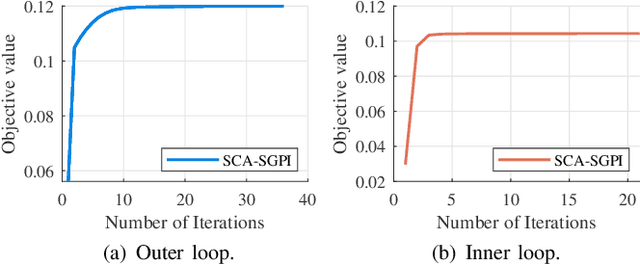
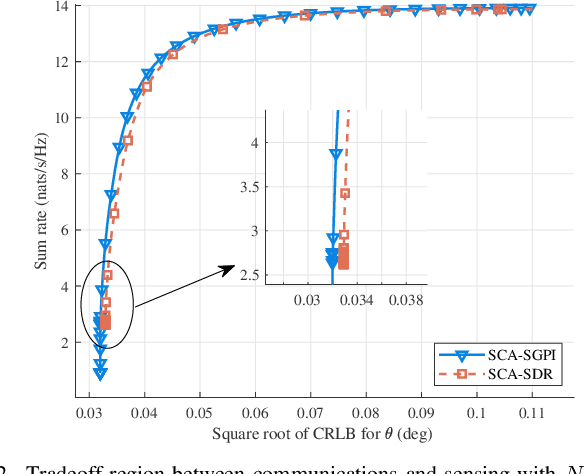
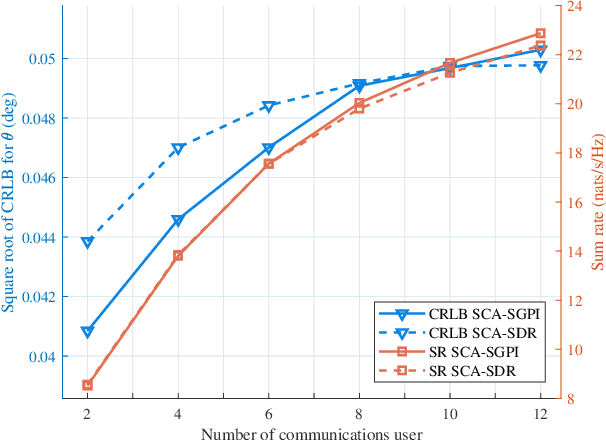

Abstract:While Cram\'er-Rao lower bound is an important metric in sensing functions in integrated sensing and communications (ISAC) designs, its optimization usually involves a computationally expensive solution such as semidefinite relaxation. In this paper, we aim to develop a low-complexity yet efficient algorithm for CRLB optimization. We focus on a beamforming design that maximizes the weighted sum between the communications sum rate and the sensing CRLB, subject to a transmit power constraint. Given the non-convexity of this problem, we propose a novel method that combines successive convex approximation (SCA) with a shifted generalized power iteration (SGPI) approach, termed SCA-SGPI. The SCA technique is utilized to approximate the non-convex objective function with convex surrogates, while the SGPI efficiently solves the resulting quadratic subproblems. Simulation results demonstrate that the proposed SCA-SGPI algorithm not only achieves superior tradeoff performance compared to existing method but also significantly reduces computational time, making it a promising solution for practical ISAC applications.
Joint Active and Passive Beamforming Optimization for Beyond Diagonal RIS-aided Multi-User Communications
Jan 17, 2025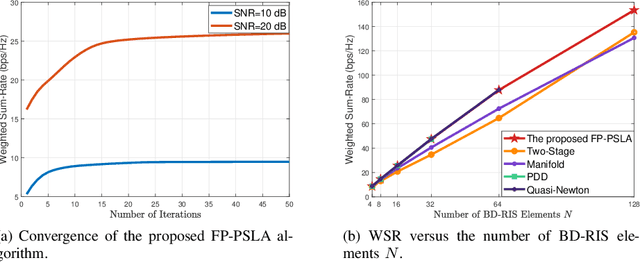
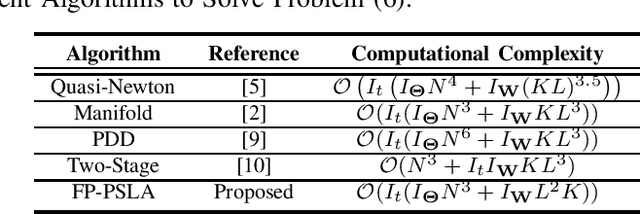
Abstract:Benefiting from its capability to generalize existing reconfigurable intelligent surface (RIS) architectures and provide additional design flexibility via interactions between RIS elements, beyond-diagonal RIS (BD-RIS) has attracted considerable research interests recently. However, due to the symmetric and unitary passive beamforming constraint imposed on BD-RIS, existing joint active and passive beamforming optimization algorithms for BD-RIS either exhibit high computational complexity to achieve near optimal solutions or rely on heuristic algorithms with substantial performance loss. In this paper, we address this issue by proposing an efficient optimization framework for BD-RIS assisted multi-user multi-antenna communication networks. Specifically, we solve the weighted sum rate maximization problem by introducing a novel beamforming optimization algorithm that alternately optimizes active and passive beamforming matrices using iterative closed-form solutions. Numerical results demonstrate that our algorithm significantly reduces computational complexity while ensuring a sub-optimal solution.
A Novel Q-stem Connected Architecture for Beyond-Diagonal Reconfigurable Intelligent Surfaces
Nov 27, 2024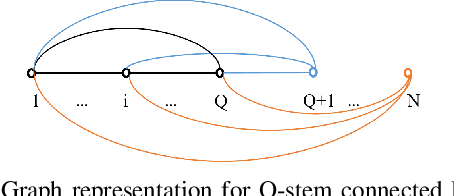
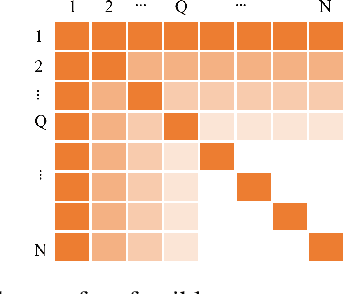


Abstract:Beyond-diagonal reconfigurable intelligent surface (BD-RIS) has garnered significant research interest recently due to its ability to generalize existing reconfigurable intelligent surface (RIS) architectures and provide enhanced performance through flexible inter-connection among RIS elements. However, current BD-RIS designs often face challenges related to high circuit complexity and computational complexity, and there is limited study on the trade-off between system performance and circuit complexity. To address these issues, in this work, we propose a novel BD-RIS architecture named Q-stem connected RIS that integrates the characteristics of existing single connected, tree connected, and fully connected BD-RIS, facilitating an effective trade-off between system performance and circuit complexity. Additionally, we propose two algorithms to design the RIS scattering matrix for a Q-stem connected RIS aided multi-user broadcast channels, namely, a low-complexity least squares (LS) algorithm and a suboptimal LS-based quasi-Newton algorithm. Simulations show that the proposed architecture is capable of attaining the sum channel gain achieved by fully connected RIS while reducing the circuit complexity. Moreover, the proposed LS-based quasi-Newton algorithm significantly outperforms the baselines, while the LS algorithm provides comparable performance with a substantial reduction in computational complexity.
Multi-Static Cell-Free Massive MIMO ISAC: Performance Analysis and Power Allocation
Nov 11, 2024
Abstract:In this work, we consider a cell-free massive multiple-input multiple-output (MIMO) integarted sensing and communications (ISAC) system with maximum-ratio transmission schemes combined with multistatic radar-type sensing. Our focus lies on deriving closed-form expressions for the achievable communications rate and the Cram\'er-Rao lower bound (CRLB), which serve as performance metrics for communications and sensing operations, respectively. The expressions enable us to investigate important operational characteristics of multistatic cell-free massive MIMO-ISAC, including the mutual effects of communications and sensing as well as the advantages stemming from using numerous distributed antenna arrays for each functionality. Furthermore, we optimize the power allocation among the access points to maximize the communications rate while guaranteeing the CRLB constraints and total transmit power budget. Extensive numerical results are presented to validate our theoretical findings and demonstrate the efficiency of the proposed power allocation approach.
Model-Based Machine Learning for Max-Min Fairness Beamforming Design in JCAS Systems
Sep 26, 2024


Abstract:Joint communications and sensing (JCAS) is expected to be a crucial technology for future wireless systems. This paper investigates beamforming design for a multi-user multi-target JCAS system to ensure fairness and balance between communications and sensing performance. We jointly optimize the transmit and receive beamformers to maximize the weighted sum of the minimum communications rate and sensing mutual information. The formulated problem is highly challenging due to its non-smooth and non-convex nature. To overcome the challenges, we reformulate the problem into an equivalent but more tractable form. We first solve this problem by alternating optimization (AO) and then propose a machine learning algorithm based on the AO approach. Numerical results show that our algorithm scales effectively with the number of the communications users and provides better performance with shorter run time compared to conventional optimization approaches.
Beamforming Design for Max-Min Fairness Performance Balancing in ISAC Systems
Jul 28, 2024Abstract:Integrated sensing and communications (ISAC) is envisioned as a key technology for future wireless communications. In this paper, we consider a downlink monostatic ISAC system wherein the base station serves multiple communications users and sensing targets at the same time in the presence of clutter. We aim at both guaranteeing fairness among the communications users while simultaneously balancing the performances of communications and sensing functionalities. Therefore, we optimize the transmit and receive beamformers to maximize the weighted minimum signal-to-interference and clutter-plus-noise ratios. The design problem is highly challenging due to the non-smooth and non-convex objective function and strongly coupled variables. We propose two efficient methods to solve the problem. First, we rely on fractional programming and transform the original problem into convex sub-problems, which can be solved with standard convex optimization tools. To further reduce the complexity and dependence on numerical tools, we develop a novel approach to address the inherent non-smoothness of the formulated problem. Finally, the efficiencies of the proposed designs are demonstrated by numerical results.
A Low-Complexity Beamforming Design for Beyond-Diagonal RIS aided Multi-User Networks
Jul 19, 2023


Abstract:Beyond-diagonal reconfigurable intelligent surface (BD-RIS) has been proposed recently as a novel and generalized RIS architecture that offers enhanced wave manipulation flexibility and large coverage expansion. However, the beyond-diagonal mathematical model in BD-RIS inevitably introduces additional optimization challenges in beamforming design. In this letter, we derive a closed-form solution for the BD-RIS passive beamforming matrix that maximizes the sum of the effective channel gains among users. We further propose a computationally efficient two-stage beamforming framework to jointly design the active beamforming at the base station and passive beamforming at the BD-RIS to enhance the sum-rate for a BD-RIS aided multi-user multi-antenna network.Numerical results show that our proposed algorithm achieves a higher sum-rate while requiring less computation time compared to state-of-the-art algorithms. The proposed algorithm paves the way for practical beamforming design in BD-RIS aided wireless networks.
 Add to Chrome
Add to Chrome Add to Firefox
Add to Firefox Add to Edge
Add to Edge